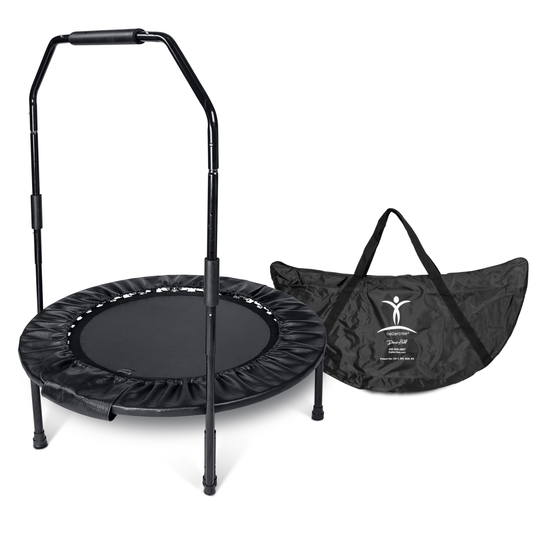Jumping may seem like an abrupt activity that wouldn't be kind to your back. However, research shows that trampoline use is a low-impact activity that causes no spine damage. We often take our back for granted until something goes wrong that causes back problems and back pain.
Not only can rebounder exercise help during recovering after a back problem, but can help prevent back problems in the first place. Learn more about how an exercise trampoline may be just what the doctor ordered for good back health.
[quote_shortcode_1]
Strengthening Back Muscles
When you think of back problems, your thoughts immediately go to the spine. The spine is made up of 24 vertebrae bones, separated by cartilage, which also connect to the sacrum and coccyx. In addition to protecting the spinal cord, the spine forms the foundation for the entire body, providing the anchor points for major muscles in the body. When problems occur with the spine, there’s usually no part of the body unaffected. Pain in the spine can radiate down the legs, and every position from standing to sitting to laying becomes painful in some way.
However, what most people don’t consider is the layer of muscles immediately surrounding the spine that help support its mission of anchoring the rest of the body. Usually, when we experience a minor back strain, what is occurring is a strain in the muscles that support the spine. When these muscles are weak through disuse, they cannot provide the support the spine needs, and more serious spinal issue can develop.

Increase Back Flexibility
Rebounder exercise is particularly beneficial for back flexibility. Because the trampoline exercise requires small movements to constantly adjust your balance, muscle coordination and flexibility is improved. Think of what happens in a windstorm when an older, less flexible tree encounters too much wind. The branches break off when they cannot flex under the pressure of the wind. The willow, however, bends easily under the strain and remains unbroken. In the same way, when your back becomes stiff and inflexible, any strain may threaten to snap one of those joints leaving you with painful back problems.
[customer_review_shortcode]
Our bodies tend to become less flexible as we age, but a big part of that problem is in how we use our bodies. Young children run and jump and play and contort their bodies into all kinds of positions we wouldn’t even dream of trying as adults. As your body stiffens up, attempting to bend your back triggers a bit of pain which conditions us to be even more inflexible. It may seem counterintuitive, but teaching your body to bend again is one of the best ways for overcoming that pain and preventing it in the future.
In rebounder exercise, the joints in your spine are stretched and compressed on each bounce, causing mild flexions that, over time, accustom your back to being more flexible and reduce back pain. Routinely participating in mini trampoline exercise breathes new life into the cartilage between the joints as well. As this cartilage goes largely unused, it tends to dry out.
[quote_shortcode_2]
Dry cartilage tends to wear away easier which can lead to painful grinding of vertebrae. The gentle stretch and compression of the vertebrae in rebounder exercise softens the cartilage and can restore its elasticity as well. This further enables the back to bend and move with less pain over time, as anyone who has used trampoline exercise for back pain will tell you.

Rebounder Exercise Is Particularly Beneficial
A trampoline workout strengthens every muscle in the body, but is particularly important for muscles involved in stability and control, like the muscles in the back. When you exercise in a mini trampoline workout, you help strengthen the muscles supporting the back, which in turn helps keep the back free of problems and painful issues.
Rebounder exercise is particularly beneficial because the springs absorb 80% of the impact, relieving your body of the stress of striking a hard surface as you do with running, jogging, or even walking. And because the rebounder demands small movements of all muscles, in a short time, you have had a full workout. The smaller impact is then further reduced by the limited time you need to work out to achieve the desired benefit.
Orthopedic surgeons recommend a trampoline workout to strengthen the back and improve flexibility, even after recovering from back issues. The reduced stress on the back as the springs absorb the impact make trampoline workouts a great choice for those who have recently recovered from back pain. The repeated, added load on the back and other bones also stimulates bone growth and density. For this reason, NASA recommends this exercise for its returning astronauts.
[advertisement_shortcode]
In addition, the health benefits of trampoline exercise are some of the greatest possible results of any exercise you can participate in. Rebounder exercise stimulates the thyroid, the lymphatic system, and the cardiovascular system. These benefits result in a healthier body that rids itself of toxins, fights off infections, and circulates necessary nutrients throughout the body better.
Give your back a rest by providing it the strength to carry your frame through rebounder exercise. One added benefit is likely to be that the back also has a bit less weight to carry as you continue.
NOTE: Remember to always consult with your doctor or health professional before starting new exercise routines.
[disclaimer_shortcode]














